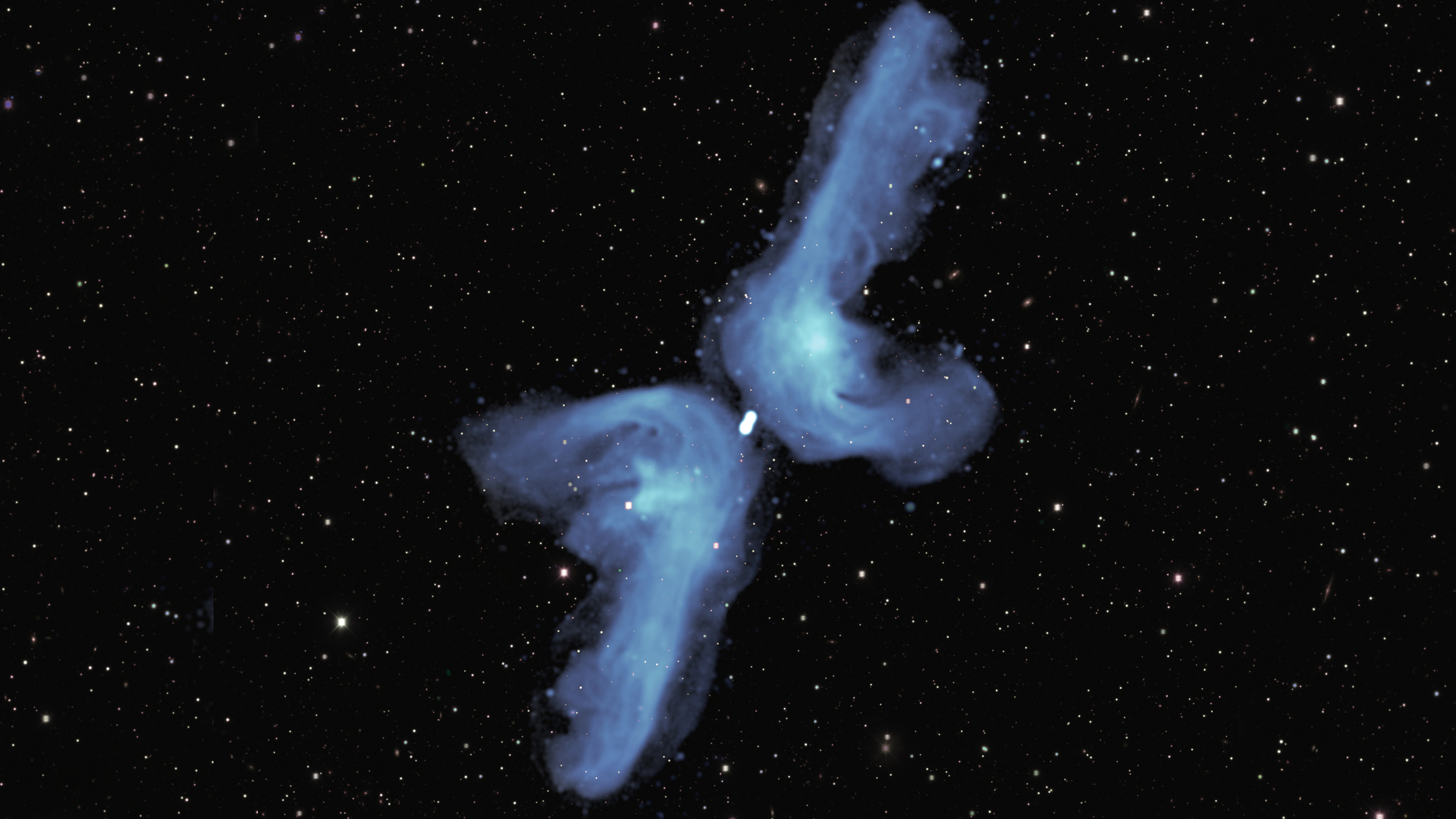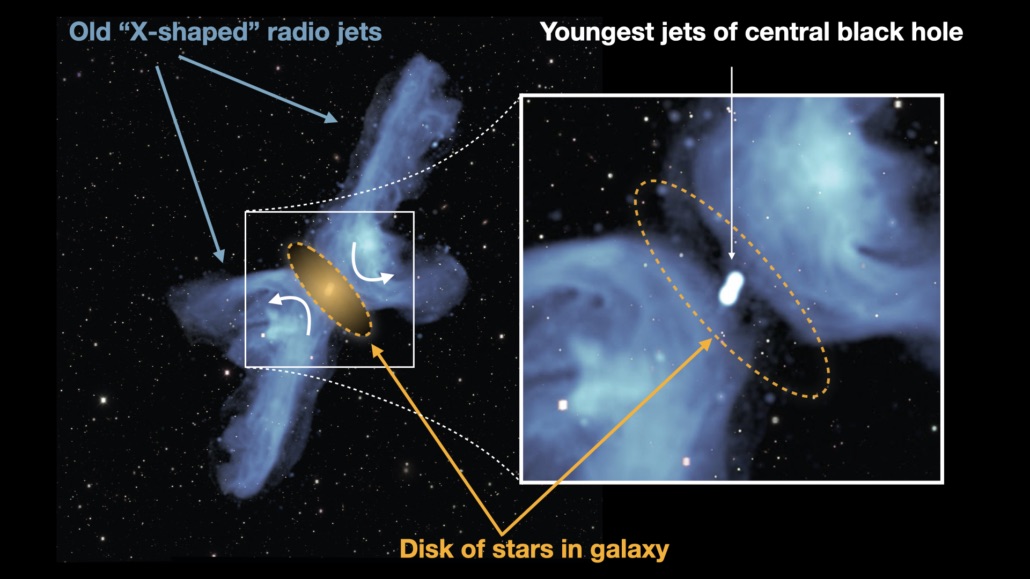The sky is full of weird X-shaped galaxies. Here's why.
A 'double boomerang' of black hole backwash lurks in this massive radio galaxy.

Spied through a normal telescope, the galaxy PKS 2014−55 is an unremarkable smudge of bright light. But look again in radio wavelengths, and you'll see that the galaxy is hiding a gargantuan, glowing treasure at its center — and X marks the spot.
PKS 2014−55 is an X-shaped radio galaxy (XRG), an unusual type of galaxy that looks like an enormous X in the night sky when imaged in radio wavelengths. The long arms of the X — each one about 100 times longer than the Milky Way — are actually a blazing-fast soup of particles and magnetic fields, blasted out of the galaxy's central black hole and traveling for millions of light-years into space, far beyond the galaxy's edge.
Big jets of radio energy are common in galaxies with hungry black holes at their centers (even the Milky Way has two "bubbles" of radio energy around its gut). However, most of those jets come in orderly pairs that appear to form a straight line or a round bulge when seen from far away. According to William Cotton, an astronomer at the National Radio Astronomy Observatory (NRAO) in Virginia who studies XRGs, fewer than 10% of known cosmic radio sources take on a distinct X shape like this one.
Related: The biggest black hole findings of 2019
"You see four things poking out of this galaxy," Cotton, lead author of a new study on the galaxy, told Live Science, "and the question is, how did it get that way?"
Now, Cotton and his colleagues may have an answer. In a new study posted May 7 on the pre-print server arXiv and accepted for publication in the journal Monthly Notices of the Royal Astronomical Society, researchers with the NRAO and South African Radio Astronomy Observatory (SARAO) used the massive MeerKAT radio telescope in South Africa's Karoo desert to capture the most detailed image of an XRG ever. The image, shown above, reveals that the strange X bursting out of PKS 2014−55's center apparently isn't an X at all.
"It's actually a 'double boomerang' shape," Cotton said. "That means something in the galaxy is diverting the flow into these secondary wings."
Get the world’s most fascinating discoveries delivered straight to your inbox.

According to Cotton and the new study, the galaxy's strange shape can be explained by a theory known as the "hydrodynamical backflow model." Here's what's happening, in a nutshell: First, the galaxy's central black hole gobbles up matter for millions of years, until it experiences a bout of cosmic indigestion. The black hole belches twin jets of matter into space, each traveling in opposite directions at incredible speed.
Eventually (tens of thousands of years later), those jets blast through the galaxy's gassy halo, traveling onward into intergalactic space. Pressure slowly builds up in the jets as they travel farther and farther out of the galaxy, ultimately forcing some material in each jet to flip around and flow back toward the center again. This phenomenon is known as "backflow."
Backflow is common in active galaxies, Cotton said, but usually all that returning material bulges up in the middle of the galaxy, rather than bouncing off to the side. In PKS 2014−55, the galaxy's hot halo of dust and gas is angled in such a way that the backflow is actually "deflected" back out of the galaxy, giving each jet a boomerang-like appearance.
To Cotton and his colleagues, this long cosmic history was evident simply by looking at the contours of the jet flow in the MeerKAT image — "We looked at the image for about 10 seconds and just said, 'yeah, that's it,'" Cotton said. But as the team analyzed the brightness of the jets, further details emerged.
According to Cotton, this image shows not one, but three separate black hole burstss separated by tens of millions of years. The two white dots near the picture's center show the most recent event, with twin lobes of energy just beginning to expand out of the black hole and into the galaxy. Beyond these, the two long blue lobes are the decaying remnants of two jets that erupted from the black hole around 10 million years ago, Cotton said.
"And, if you look around the edges of the jets, there's what we call a 'cocoon' — the faint remnant of an even earlier outburst," he added. "That's something on the order of 100 million years old."
The fact that all three generations of jets appear to follow the same boomerang pattern suggests that hydrodynamical backflow explains this XRG's shape, rather than some other phenomenon (such as the black hole changing direction between one jet outburst and the next).
The same model may not explain every X-shaped galaxy in the universe — each one requires its own analysis, Cotton said. But, at least in the case of PKS 2014−55, that’s one cosmic treasure map solved.
- 15 Unforgettable images of stars
- The 15 weirdest galaxies in our universe
- 9 Ideas about black holes that will blow your mind
Originally published on Live Science.
OFFER: Save 45% on 'How It Works' 'All About Space' and 'All About History'!
For a limited time, you can take out a digital subscription to any of our best-selling science magazines for just $2.38 per month, or 45% off the standard price for the first three months.

Brandon is the space/physics editor at Live Science. His writing has appeared in The Washington Post, Reader's Digest, CBS.com, the Richard Dawkins Foundation website and other outlets. He holds a bachelor's degree in creative writing from the University of Arizona, with minors in journalism and media arts. He enjoys writing most about space, geoscience and the mysteries of the universe.

